Abstract
Bulbophyllum lampadion from New Guinea is herein described and illustrated based on herbarium specimens and cultivated material. This high-elevation species belongs to section Monanthes, of which sect. Oxysepala is here considered to be a synonym.
Keywords: Hotspot; Indonesia; Papua New Guinea; sectional classification; sect. Oxysepala
Introduction
New Guinea is a remarkable hotspot of Bulbophyllum diversity, with approximately 690 recorded species, accounting for nearly a third of the genus’ total diversity (De Vogel et al. 2024). New species continue to be described (e.g., Saputra et al. 2023, Vermeulen & Schuiteman 2021, Vermeulen et al. 2018, 2020), with many more expected as previously inaccessible areas are surveyed.
The tiny but colorful and floriferous species to be described below was apparently first collected by Tom Reeve and Tim Rees in 1981 in the Enga Province of Papua New Guinea. It has since been found on a few occasions in other localities in the Enga and Southern Highlands Provinces (Fig. 1). Specimens allegedly from Indonesian New Guinea have entered trade channels.
The sectional classification of Bulbophyllum is still in flux. Sampling for phylogenetic studies has been uneven and often insufficient, particularly for groups predominantly found in New Guinea (Vermeulen et al. 2014). Based on morphological characters, the new species would be classified in sect. Monanthes (Blume) Aver. This classification is primarily based on the trait set, ‘1-flowered inflorescences with small flowers, connate lateral sepals, absence of node displacement at the base of the pedicel (pedicel node level with the floral bract attachment) and the presence of 2 pollinia (versus 4)’. While connate lateral sepals distinguish this section from sect. Oxysepala (Wight) Benth. & Hook.f., this trait is variable in other sections of Bulbophyllum. Therefore, following Vermeulen et al. (2015), we consider the distinction between sections Monanthes and Oxysepala to be artificial and prefer to unite them in a single section, for which the name Monanthes has priority. In this broader sense, sect. Monanthes (long known as sect. Polyblepharon Schltr.) includes over 150 provisionally accepted species.
Vermeulen et al. (2014) provide a key to the sections of Bulbophyllum, where members of sect. Oxysepala key out under Bulbophyllum sect. Monanthes. Vermeulen et al. (2015) overlooked that sect. Monanthes had priority, and used the name Oxysepala, providing descriptions of sect. Monanthes (as Oxysepala) and its Bornean species, which together offer an impression of the various morphologies within the section. Although members of this section range from the Himalayas to the West Pacific Islands and Australia, most of the species are endemic to the island of New Guinea (De Vogel et al. 2024).
De Vogel et al. (2024) summarize the published information on the New Guinean species of the section (under section names Monanthes and Oxysepala). They divide the species with adnate lateral sepals in four convenient, but probably not monophyletic species-groups. These groups are based on combinations of two characters: rhizome creeping versus patent, and presence/ absence of auricles near the base of the lip (sect. Monanthes, species-groups b to e).
The species described here is classified as a member of sect. Monanthes following Vermeulen et al. (2014), and according to De Vogel et al. (2024) would be placed in species-group c of this section (rhizomes creeping; lip without auricles near the ligament), a species-group with a taxonomy that is complex and largely unresolved.
Taxonomic treatment
Bulbophyllum lampadion J.J.Verm., M.Perry & Schuit., sp. nov.
TYPE: Papua New Guinea. Enga Province: Mt. Wambup (S of Laiagam) near Crater Lake, 3450 m, 22 X 1981, Rees & Reeve 222 (holotype K! K001881923). Fig. 2 - 4.
Bulbophyllum lampadion J.J.Verm., M.Perry & Schuit., detail of holotype specimen, Rees & Reeve 222 (K001881923).
Diagnosis: The new species belongs to a small species-group within section Monanthes characterized by a creeping rhizome, adnate lateral sepals and the absence of auricles at the base of the lip. Within this species-group, only B. vutimenaense B.A.Lewis from Vanuatu shares the combination of a slender peduncle and a minutely papillose lip with B. lampadion; the latter differs in particular by the lip, which is not callous distally.
Rhizome creeping or shortly ascending, sparsely branched, 0.8-1.0 mm in diameter, sections between pseudobulbs 1.5-3.8 mm long, rhizome scale fibers not persistent. Pseudobulbs minute, (ellipsoid-)cylindrical, 3.5-7.0 × 1.8-2.4 mm, distally grooved but not angular. Leaves elliptic to obovate, 0.8-2.4 × 0.24-0.62 cm, ratio length/width 2.6-4.4; acute(-apiculate); petiole 1-2 mm long. Inflorescences fasciculate, forming dense, broom-like clusters over time, 1.6-4.4 cm long, 1-flowered. Peduncle 1.2-3.7 cm long, scale 1, basal, ca. 1.8 mm long. Floral bract ca. 2 mm long. Flowers non-resupinate; sepals and petals white, distally bright orange; lip yellow, orange-yellow distally; column and anther white. Pedicel-with-ovary 0.8-1.2 mm long, basal node level with the floral bract attachment. Dorsal sepal free, thin, distally thickened, somewhat recurved, ovate-triangular, ca. 3.7 × 1.2 mm, ratio length/width 3.0-3.1; acute, margins entire; glabrous, 3-veined. Lateral sepals recurved, adnate along their lower margins, as the median but slightly oblique, ca. 3.6 × 1.1 mm, ratio length/width 3.2-3.3. Petals thin, distally thickened, porrect or somewhat recurved, ovate, ca. 2.8 × 1.1 mm, ratio length/width 2.5-2.6; acute, margins entire, minutely papillose distally, surface glabrous; 1-3-veined. Lip curved, sometimes strongly so, particularly halfway along its length, thick, elliptic-ovate, ca. 1.2 × 0.7 mm, ratio length/width ca. 1.7 (without spreading); obtuse, minutely papillose towards the apex, margins without proximal auricles; adaxially slightly concave and with a low, obtuse median ridge towards the base, slightly convex towards the apex; abaxially convex near the base, approximately flat elsewhere. Column including stelidia ca. 0.7 mm long, stigma approx. circular, foot short, not thickened. Stelidia porrect, ca. 0.3 mm long, subulate, subacute. Pollinia 2 [description mainly after cult. M. Perry 655].
Etymology: Derived from the diminutive of λαμπάς (ancient Greek) = torch, referring to the brightly colored flowers.
Distribution: Papua New Guinea (Enga and Southern Highlands Provinces) and allegedly Indonesia (Papua Province); endemic in New Guinea.
Additional material studied: Papua New Guinea. Enga Province: Kandep Range, Laiagam-Kandep Road, 3000 m, 2 VIII 1982, Reeve 4776 (K! K001881920, LAE); Mt. Maip, Laiagam, Porgera Road, 2700 m, 30 IX 1983, Reeve 6782 (K! K001881921, LAE); Tomba Pass, cult. Kumul Lodge s.n. (photographs by Graham Corbin!). Southern Highlands Province: Tari Gap, 2800 m, cult. Tineke Roelfsema s.n. (photographs by André Schuiteman!). ?Indonesia. Presumably Papua Province: cult. M. Perry 655 (K!, spirit material).
Habitat and ecology: Epiphyte in upper montane forest margins and on trunks of tree ferns (Sphaeropteris atrox (C.Chr.) R.M.Tryon) in subalpine grassland. It occurs at elevations of 2700 to 3450 m.
Phenology: Flowering observed in the wild during August, September, and October.
Acknowledgements
The distribution map was created by AS using the free online tool SimpleMappr (https://www. simplemappr.net). We thank Graham Corbin for sharing photographs of New Guinea Orchidaceae, and the late Tineke Roelfsema for inviting AS on a trip to Papua New Guinea in 1990, during which B. lampadion was found. We are grateful to the reviewers for suggesting several improvements.
Author contributions. JJV and AS wrote the text, JJV created the line drawing, AS created the distribution map, MP provided spirit material and photographs, and commented on the manuscript.
Funding: No funding available.
Conflict of interest: No conflicts of interest declared.
Literature cited
-
Saputra, R., Mustaqim, W. A., Champion, J. & Schuiteman, A. (2023). Bulbophyllum wiratnoi (Orchidaceae), a new species of section Epicrianthes from Indonesian New Guinea. Phytotaxa, 589(3), 283-288. doi: 10.11646/phytotaxa.589.3.7
» https://doi.org/10.11646/phytotaxa.589.3.7 - Vermeulen, J. J. & Schuiteman, A. (2021). Bulbophyllum cophocropion (Orchidaceae), a new species from Papua New Guinea. OrchideenJournal Internet ed., 9(1), 3-5.
- Vermeulen, J. J., Fischer, G., Camargo Smidt, E. de, Stern, W. L., Pridgeon, A. M., Veitch, C., Sieder, A., Vugt, R. van & Gravendeel, B. (2014). Bulbophyllum In: A. M. Pridgeon, P. J. Cribb, M. W. Chase & F. N. Rasmussen (Eds.), Genera Orchidacearum vol. 6, Epidendroideae (part three) (pp. 4-51). Oxford: Oxford University Press.
- Vermeulen, J. J., O’Byrne, P. & Lamb, A. (2015). Bulbophyllum of Borneo (pp. i-viii, 1-728). Kota Kinabalu: Natural History Publications.
- Vermeulen, J. J., Schuiteman, A. & De Vogel, E. F. (2018). New taxa in Bulbophyllum (Orchidaceae: Epidendroideae: Malaxideae) from New Guinea, lifting a mega-genus over the 2000-Species mark. Malesian Orchid Journal, 21, 31-68.
-
Vermeulen, J. J., Schuiteman, A. & De Vogel, E. F. (2020). Sixteen new species of Bulbophyllum section Polymeres (Orchidaceae) from New Guinea. Lankesteriana, 20(3), 301-330. doi: 10.15517/LANK.V20I3.44438.
» https://doi.org/10.15517/LANK.V20I3.44438. -
De Vogel, E. F., Vermeulen, J. J. & Schuiteman, A. (2024). Orchids of New Guinea Retrieved from Retrieved from www.orchidsnewguinea.com
[Accessed March 2024].
» www.orchidsnewguinea.com
Publication Dates
-
Date of issue
May-Aug 2024
History
-
Received
20 May 2024 -
Accepted
17 July 2024

 Bulbophyllum lampadion (section monathes), a new species from new Guinea
Bulbophyllum lampadion (section monathes), a new species from new Guinea
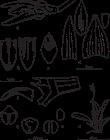
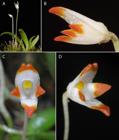


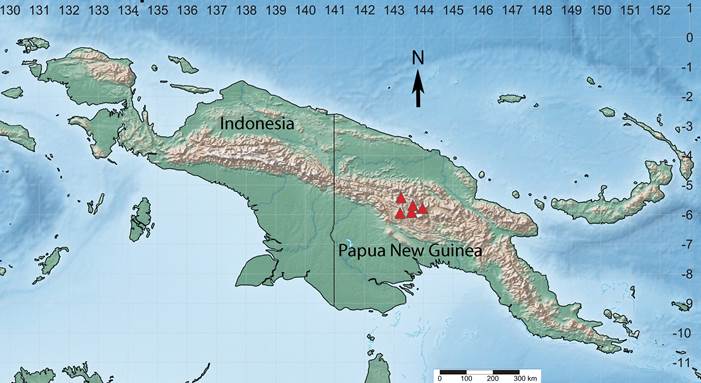
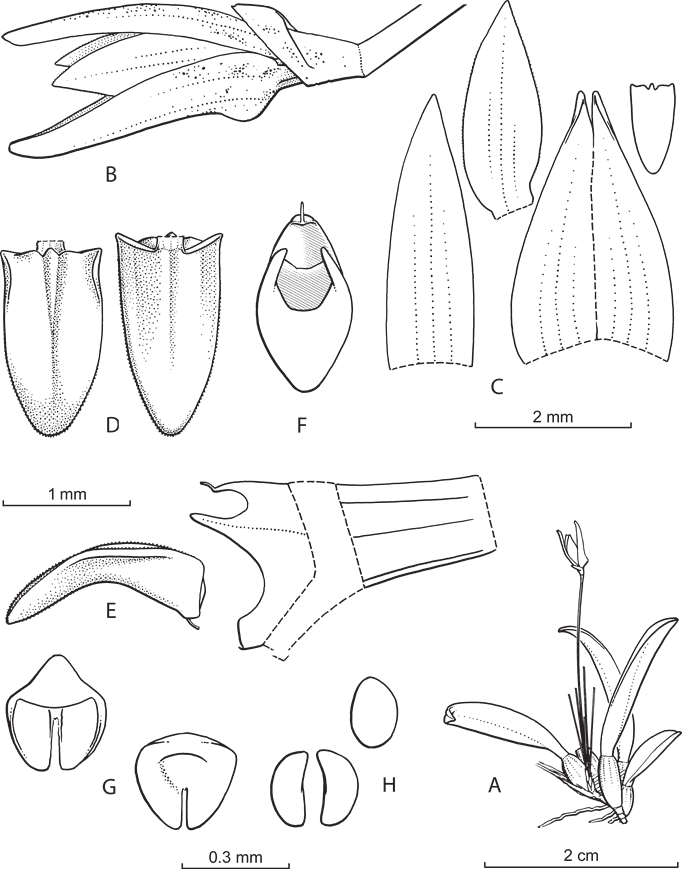 Illustration by Jaap J. Vermeulen based on spirit material of Perry 655. A. Habit. B. Flower. C. Flower analysis, from left to right: median sepal, petal, lateral sepals, lip. D. Lip, left: adaxial side, right: abaxial side. E. Column and lip, lateral view. F. Column, frontal view. G. Anther, left: adaxial side, right: abaxial side. H. Pollinia, above: a single pollinium, below: a pair.
Illustration by Jaap J. Vermeulen based on spirit material of Perry 655. A. Habit. B. Flower. C. Flower analysis, from left to right: median sepal, petal, lateral sepals, lip. D. Lip, left: adaxial side, right: abaxial side. E. Column and lip, lateral view. F. Column, frontal view. G. Anther, left: adaxial side, right: abaxial side. H. Pollinia, above: a single pollinium, below: a pair.
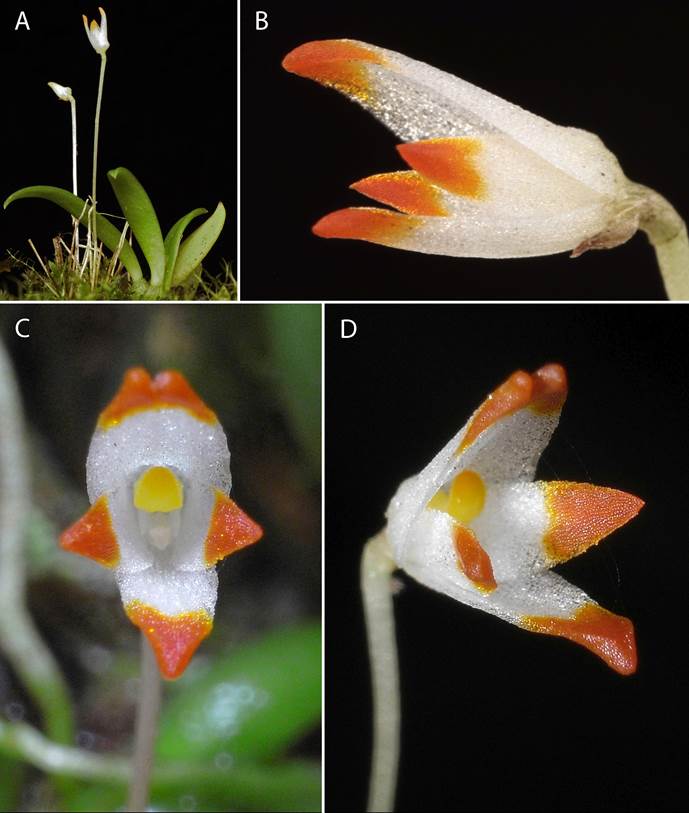 Photographs by Malcolm Perry (A, B) and Graham Corbin (C, D). A. Plant. B-D. Flower. From Perry 655 (A, B), and Kumul Lodge cult. s.n. (C, D).
Photographs by Malcolm Perry (A, B) and Graham Corbin (C, D). A. Plant. B-D. Flower. From Perry 655 (A, B), and Kumul Lodge cult. s.n. (C, D).
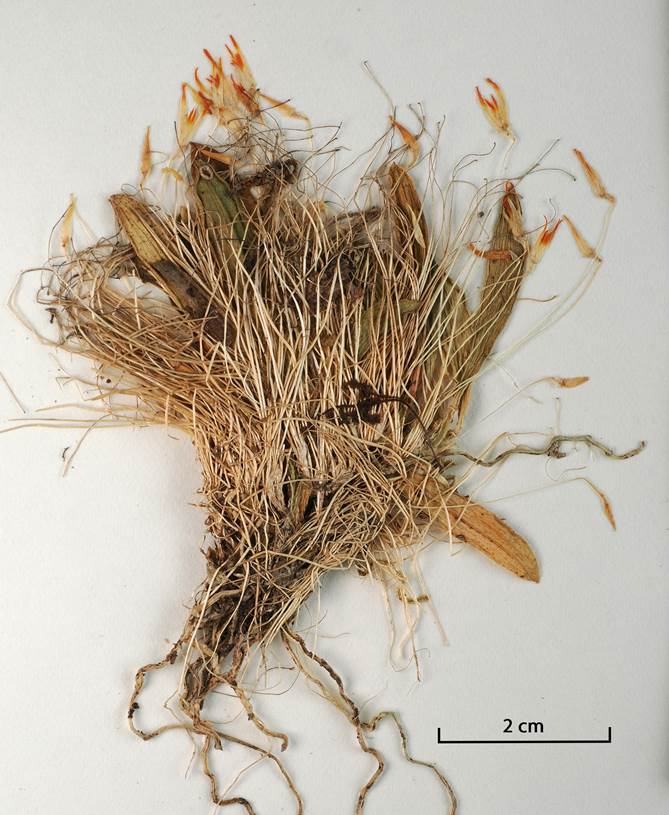 Reproduced with permission of the Board of Trustees of the Royal Botanic Gardens, Kew.
Reproduced with permission of the Board of Trustees of the Royal Botanic Gardens, Kew.